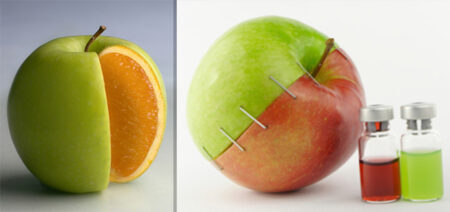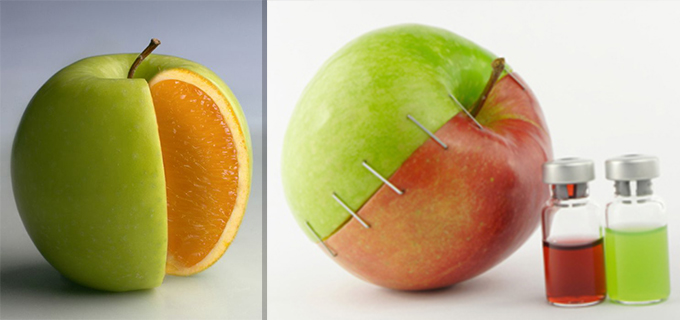We explain Advantages and Disadvantages of GMOs Foods.Genetically modified organisms (GMOs) are those microorganisms , plants or animals whose hereditary material (DNA) is manipulated through biotechnology techniques. Through genetic modification it is possible, to alter the expression of a gene or to transfer it to another organism (of the same or a different species) .
Advantages and Disadvantages of GMOs Foods.

Biotechnology techniques applied to genetically modified organisms are also called “modern biotechnology”, “genetic technology”, “ DNA technology ” or “genetic engineering”. They are used, to a greater extent, in the food industry ( agriculture and livestock ) and in medicine (for vaccines or to reverse hereditary diseases).
Like all technologies, transgenic foods have benefits and risks that must be taken into account for the greatest benefit of humanity.
| Advantages | Disadvantages | |
|---|---|---|
| for the economy |
|
|
| for the environment |
|
|
| To health |
|
|
Advantages of transgenic foods
The advantages result from the improvement or utility that genetically modified organisms bring to the different areas of human endeavor. Among the advantages we have:
1. Accelerated product growth
Knowing the physiology of organisms, it is possible to discover the genes that are involved in growth mechanisms. This can be used to produce larger or faster growing animals or plants.
For example, transgenic salmon take half the time to reach adult size as wild salmon. This gives you a marketing advantage in less time.
2. Increased production
The productivity of agricultural crops is diminished by the presence of weeds, which compete for water and nutrients. One strategy to eliminate competing weeds is to modify plants of agricultural interest, such as corn and soybeans, so that they are resistant to herbicides.
3. Defense against agricultural diseases
In some regions of the world crops are attacked by viruses, fungi or bacteria that destroy them, causing great economic losses. Through bioengineering techniques, foods capable of resisting the attack of these agents can be built.
For example, the papaya is affected by a virus that destroys the plant. A papaya resistant to this virus was developed, which made it possible to recover the cultivation of this fruit in many regions.
4. Fight nutritional deficiencies
Disease-producing nutritional deficiencies exist in many human populations. This is usually due to the difficulty in accessing certain types of food. Supplementation is an expensive measure and is not available to everyone.
For example, in certain areas of Asia there is a deficiency of vitamin A that causes vision problems and infant mortality. To combat this problem, rice was designed that could produce a vitamin A precursor. This is known as golden rice.
5. Fight pests in agriculture
The Bacillus thuringensis bacterium produces an insecticide that is commonly used to protect crops. It has been possible to insert the gene of this bacterium in some plants, in such a way that the plant can produce the insecticide by itself.
6. Precision in the desired characteristics
Since the creation of agriculture, human beings have selected the best plants and animals for their consumption. Through artificial selection and hybridization, the production of certain species was favored, but this is very time consuming and failing. For example, the maize we know today took millennia and originated from a plant (teosinte) that had only a few grains.
With biotechnology, the desired effect can be specified, such as producing a pig with more muscles or a cow with greater milk production. This process is much faster than artificial selection or hybridization, as well as being easier to control.
7. Reducing the impact of agriculture on the environment
The use of fertilizers, pesticides, herbicides and antibiotics are practices of the agricultural industry that alter the environment. With the creation of organisms resistant to pests and with greater growth, the use of toxins and substances that can alter the balance of ecosystems is reduced.
8. Reduction of harmful toxins to humans
Corn that is affected by insects is more likely to be infected by mycotoxin-producing fungi. These mycotoxins cause liver damage, are carcinogenic, and pregnant women who consume mycotoxin-contaminated corn are at increased risk of having birth defects.
With the introduction of the gene of the bacterium Bacillus thuringensis in maize, the levels of mycotoxin in the ears are reduced.
9. Preservation of biodiversity
With the implementation of more productive transgenic crops, the need to intervene in virgin areas will be reduced. In this way, the wild fauna and flora is protected from the impact of transforming the forest for agricultural use.
On the other hand, with the reduction in the use of synthetic pesticides with a non-specific effect, the diversity of insects that do not affect crops is maintained.
Disadvantages of GM foods
GM foods present some risks and problems if their implementation is not properly regulated.
1. Biological competition with the original species
One of the risks posed by the use of genetically modified organisms is that they have a better development with respect to the native species, establishing a competition for the available resources. This can lead to the decline and potential disappearance of the original species.
2. Large investment financed by large companies
Genetic engineering processes are expensive and large biotech companies dominate the market for GM foods. In addition, the excess of regulations decreases the economic interest to develop these organisms on the part of public institutions. This promotes the establishment of oligopolies that can control the market.
3. Potential negative effects on human health
Opponents of GM foods argue that genetically modified foods can cause allergies or other health problems. In this sense, to ensure that an organism of this type is safe for human consumption, different tests and analyzes are carried out before marketing it.
On the other hand, controlled studies of GM foods show that they are no more prone to disease than normal foods. For example, cassava if not prepared correctly can cause death.
4. Loss of biodiversity
One of the most widespread risks is the disappearance of native species due to the superiority of transgenic foods. This has been solved by creating genetically modified organisms unable to reproduce.
5. Complications to regulate and legalize the marketing of transgenic foods
The Cartagena Protocol on Biosafety is an agreement between different countries that establishes the rules for the import and export of living organisms with modifications to their genome.
However, each country is responsible for establishing the laws for the use of transgenic foods. For example, transgenic salmon is commercialized in Canada, while in the neighboring country, the US, its approval has been delayed.
6. Ethical implications
Genetic manipulation of any kind has always raised concerns about what is right or necessary. Securing human nutrition could be a reason to produce more and better transgenic foods.
But is it ethical to create a glow-in-the-dark fish to make it easier to catch? Does it help food safety to produce a blue decorative corn without any extra nutritional value?
7. Negative effects on wildlife
The use of some herbicides on crops that are resistant to them not only kill weeds, they can also affect wildlife, such as beneficial pollinating insects
